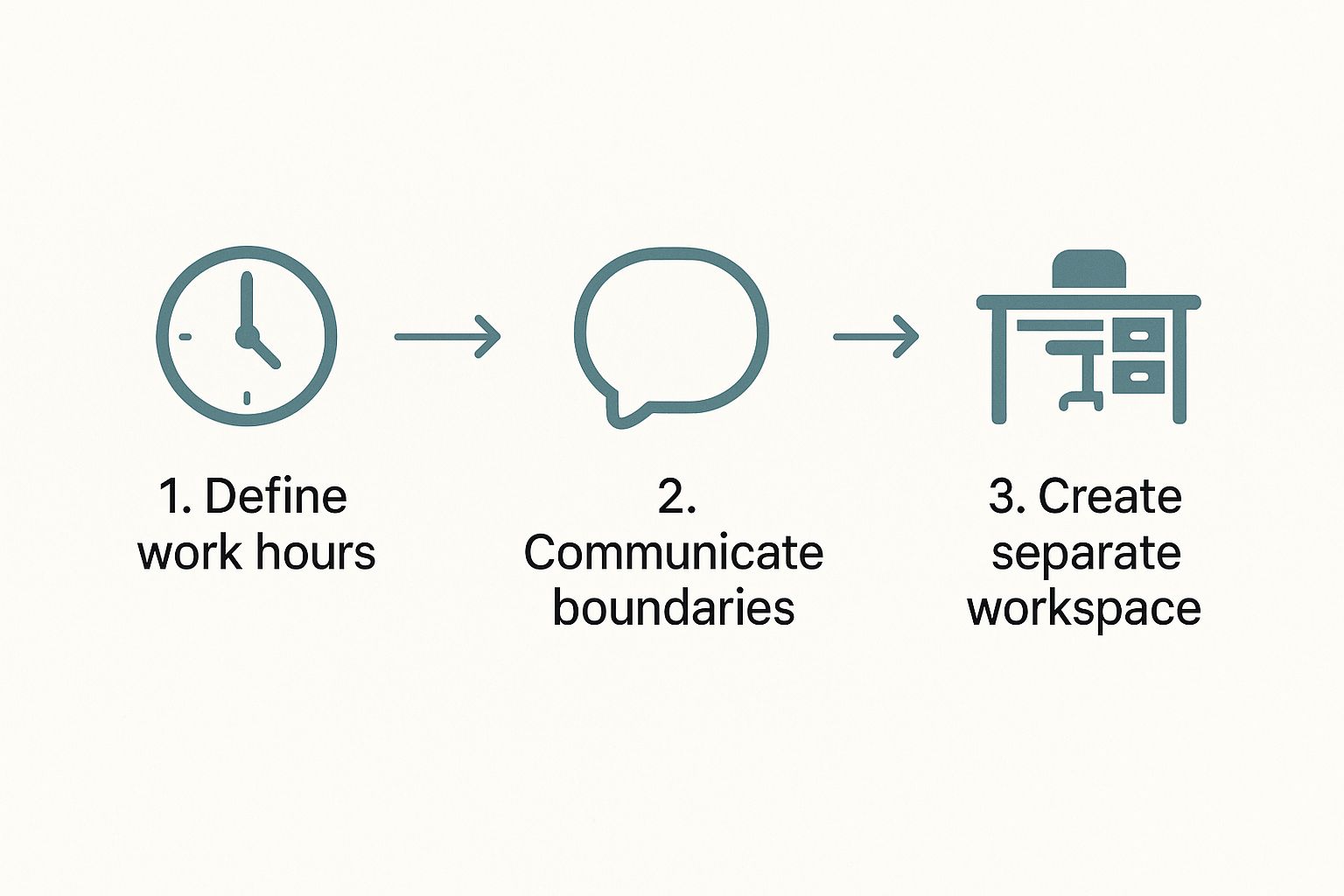
How to Stop Thinking About Work and Reclaim Your Evenings
Share
Does your brain ever feel like it has way too many browser tabs open, and every single one is work-related? If you’ve ever found yourself replaying a conversation with a colleague or mentally drafting an email while trying to fall asleep, you know how frustrating it is. Learning how to stop thinking about work isn't about flipping a switch; it's about creating simple, practical boundaries and rituals that give your mind permission to finally log off. This guide will walk you through actionable steps to build that mental firewall and reclaim your personal time.
Why It Feels Impossible to Mentally Clock Out

You’ve technically finished for the day, but your mind is still churning through unfinished tasks, replaying conversations, and stressing about tomorrow's deadlines. If this sounds familiar, you're not alone.
This isn't a personal failing. It’s a very real, modern challenge, especially for people who are passionate about what they do—K-12 educators, content creators, and small business owners know this feeling all too well.
When you genuinely care about your work, the line between your professional and personal life gets fuzzy. You're invested in your students' progress, your clients' success, or your next creative project. That dedication is a superpower, but it's also what makes it so tough to switch off.
The "Always-On" Trap
Let's be honest, our digital tools don't help. A single notification buzz from your phone at 8 PM can yank you right back into work mode, even if you’re in the middle of family time. Before you know it, your brain starts associating your personal spaces, like your living room or even your bedroom, with work stress.
This constant mental tether to your job just isn't sustainable. Think of it like a muscle that’s always tensed up; eventually, it gets strained, exhausted, and just can't perform at its best.
For many of us, the inability to disconnect comes from a belief that more thinking equals better problem-solving. But the truth is, real breakthroughs often pop up when we give our minds a break, not when we're relentlessly chewing on a problem.
It Comes Down to Time and Balance
The data backs this up. Global surveys consistently show a direct link between long hours and the struggle to shut off work thoughts. Just look at a country like Italy, which scores an impressive 9.4 out of 10 for work-life balance. Only 3% of Italian employees work more than 50 hours a week, which is way below the international average of 10%.
This cultural focus on personal time makes a huge difference in preventing mental burnout. If you're curious, you can explore more work-life balance statistics to see how different countries handle it.
Recognizing these external pressures is the first step. It's not just you; it's the environment we work in. Learning how to stop thinking about work is a crucial skill for modern life, not a sign that you're not dedicated enough.
Create Practical Boundaries That Actually Work

Hearing the advice to "just set boundaries" can be incredibly frustrating. It sounds simple, but it feels impossible when your email is pinging at 9 PM. Vague advice doesn't help you figure out how to stop the mental hamster wheel when it feels like work is always on.
So, let's get into concrete actions you can take today.
Effective boundaries aren't about building a giant wall around your personal life. Think of them more like intentional doorways—you decide when they open and when they close. This is how you start proactively reclaiming your time and mental space.
Define Your Digital Off-Switch
Our devices are often the biggest culprits in blurring the lines between our work and personal lives. The trick is to create clear separations that signal to your brain when it's "work mode" and when it's "rest mode."
For an educator, this could be as simple as creating a separate user profile on your laptop just for school. When you log into your "Personal" profile, you won't be staring at icons for grading software or lesson plans. It's a small but surprisingly powerful digital partition.
If you're a content creator, you might try physically putting your work phone in a drawer after 6 PM. Just getting it out of sight makes it harder to mindlessly check for comments or emails, breaking that compulsive loop.
Communicate Your Availability Clearly
A huge piece of setting boundaries is managing the expectations of colleagues, clients, or parents. Many of us avoid this because we're afraid of seeming uncommitted. But communicating your hours clearly and professionally is actually a sign of respect—for your time and for theirs.
You don’t need to send a company-wide memo. Instead, use small, consistent signals:
- Add your hours to your email signature. A simple line like, "My working hours are 9 AM to 5 PM, and I'll respond during that time," sets a clear, professional expectation.
- Use an out-of-office auto-responder. Set it to switch on the minute your workday ends. A friendly note that says you've received their message and will reply the next business day works wonders.
- Embrace scheduling tools. Instead of endless back-and-forth emails, use a tool like Calendly to let people book meetings only during your designated work blocks. This AI-powered tool can save you hours of admin time.
The goal isn't to be unreachable; it's to be predictably reachable. When people know when to expect a response, the pressure to be "always on" goes down for everyone. This is a game-changer for educators, who can explore more tailored teacher time management strategies to guard their off-hours.
Create Physical No-Work Zones
Just as you create digital separations, you need to establish physical "no-work zones" at home. When your workspace bleeds into your relaxation space, your brain never gets the memo that it's okay to fully disconnect.
This doesn't mean you need a dedicated home office. A no-work zone can simply be your bedroom or the dining table. The rule is simple: no laptops, no work calls, and no checking emails in that space. Over time, your brain will start to associate those areas purely with rest, making it much easier to leave work thoughts behind.
Design a 'Shutdown Ritual' to End Your Workday
Setting boundaries is one thing, but how do you actually get your brain to clock out? The secret is a "shutdown ritual." This isn't a complex, time-consuming habit. It's a simple, repeatable series of actions that consciously shifts you from "work mode" to "home mode."
Think of it like a modern-day commute. For those who used to leave a physical office, the drive or walk home created a natural buffer. A shutdown ritual does the same job, giving your mind a clear signal that it’s time to stop thinking about projects and deadlines.
Without this deliberate transition, work thoughts have a nasty habit of bleeding into your evening, which is a perfect recipe for burnout.
Building Your Personal Routine
The best shutdown ritual is personal to you and, most importantly, consistent. It’s about creating a short, predictable sequence that draws a firm line between your professional and personal time. The goal is to close all the mental "tabs" related to work so they aren't draining your energy all night.
For instance, a teacher I know spends five minutes tidying their desk, another five writing down the top three priorities for the next school day, and then physically closes their laptop. That final click of the laptop lid is a powerful symbolic gesture. Work is done.
This visual guide breaks down the core elements of creating this structure.

As you can see, defining your hours and workspace first makes your end-of-day ritual much more effective.
Tailoring the Ritual to Your Role
What works for a freelance writer probably won't be the right fit for a business owner managing a team. The beauty of this concept is its flexibility. You can, and should, design a ritual that fits your unique work demands.
Here are a few practical examples to get you started.
Sample Shutdown Rituals for Different Professions
| Profession | 5-Minute Action | 10-Minute Action | Physical Transition |
|---|---|---|---|
| Educator | Tidy physical desk space and file papers. | Review tomorrow's lesson plan and jot down the top 3 priorities. | Close laptop and put it away in a bag, out of sight. |
| Creator | Clear your creative workspace of clutter. | Review the next day's content calendar and close all editing software. | Turn off your studio lights and close the door to your workspace. |
| Business Owner | Scan calendar for morning appointments. | Send an "end of day" update to the team on Slack. | Power down the work computer completely (not just sleep mode). |
These are just starting points. The key is to find a sequence that feels final and brings a sense of completion to your day.
The most crucial part of any ritual is the final, definitive step. Whether it’s turning off a specific lamp, changing out of your "work clothes," or putting on a specific playlist, this physical action solidifies the mental shift.
For more in-depth help, our collection of Work-Life Balance Guides & Checklists offers downloadable resources to walk you through designing and sticking to these powerful routines. A well-crafted ritual is one of the most effective tools for reclaiming your evenings.
Mindful Techniques to Calm a Busy Mind

So, you’ve set your boundaries and have your shutdown ritual. But then, just as you’re settling into your evening, a rogue work thought crashes the party. The instinct is to fight it, but that usually just makes it louder.
Instead of wrestling with your brain, there are a few simple mindfulness tricks you can use to gently guide your attention back to your personal time. No meditation experience needed.
The idea isn't to force your mind into perfect, silent bliss. The real goal is to change your relationship with these intrusive thoughts—to see them less as urgent alarms and more like passing clouds. This shift is key to actually stop thinking about work without adding more stress to the pile.
Acknowledge Thoughts Without Judgment
One of the most powerful and surprisingly simple methods is thought labeling. When a work worry pops into your head, just give it a name.
Let's say you suddenly start stressing about that project deadline. Instead of getting caught up in the anxiety, you can just quietly say to yourself, "Ah, there’s a work thought." That's it. You don't have to engage with it, analyze it, or beat yourself up for having it.
This small act creates a sliver of space between you and the thought. You move from being tangled up in the thought to simply observing it. Over time, this practice strips these thoughts of their power, helping them float by without pulling you into a downward spiral.
By labeling a thought, you take away its urgency. You’re telling your brain, "I see this, but it’s not what I'm focusing on right now." It’s a gentle but firm way to protect your mental peace.
Create a Designated Worry Window
This might sound counterintuitive, but setting aside a specific time to worry can be a game-changer. It's a technique called scheduled worry time, and it’s all about containing work anxiety instead of letting it run wild all evening.
Here’s the simple breakdown:
- Set a Timer: Pick a short 10 or 15-minute window each day, ideally a few hours before bed.
- Worry on Purpose: During this time, give yourself full permission to think, stress, and brainstorm about every single work thing on your mind. Writing them down can be especially helpful.
- Postpone Worries: If a work thought shows up outside this scheduled slot, gently tell yourself, "Not now. I'll deal with that during my worry time." Then, turn your attention back to what you were doing.
This strategy respects your brain’s need to process things but puts you back in the driver's seat. You decide when to deal with work stress, which helps prevent those late-night anxiety sessions that wreck your sleep.
If you're looking for more ways to handle these feelings, our guide on practical workplace stress management techniques is a great next step. Pairing these mindful practices together gives you a robust toolkit for keeping your mind calm and present.
Find a Hobby That Demands Your Full Attention
Truly unplugging isn't about forcing yourself to stop thinking about work. Sitting on the couch trying not to think about that looming project is a losing battle. Your mind needs a better offer—something genuinely engaging to latch onto.
This is where immersive hobbies come in. When an activity demands your complete focus, it literally crowds out those persistent work thoughts. Think about trying to follow a complex new recipe, practicing a tricky chord on a guitar, or focusing on your next move while rock climbing. There's simply no mental bandwidth left for work.
Activities like these can help you find a state of flow, that feeling of being so completely absorbed in what you're doing that you lose track of time. Your brain is too busy to entertain work-related stress.
How to Find Your Flow
The trick is to pick something that's challenging but not so difficult that it becomes frustrating. It needs to require just enough concentration to completely capture your attention.
Not sure where to start? Think about what might totally absorb you:
- Get Creative: Try pottery, painting, coding a simple app, or even writing a short story. These all require you to focus intently on the creative process.
- Get Physical: Learn a new dance routine, take up a martial art, or get into intricate gardening. These activities force you to be present in your body and mindful of every movement.
- Get Strategic: Chess, a complex board game, or a deeply strategic video game can completely hijack your cognitive functions, leaving no room for anything else.
Rest isn't idleness, and a hobby that recharges you is one of the most productive things you can do. It doesn’t just improve your mood; it sharpens the creativity and problem-solving skills you'll take back to your desk the next day.
This mindset is becoming more common as the old "hustle at all costs" culture begins to fade. We're seeing a real shift, especially with younger generations who are drawing a firm line to protect their mental health.
A New Generation’s Take on Work and Life
This isn't just a feeling; it's a measurable cultural shift. Deloitte's 2025 Global Gen Z and Millennial Survey puts this into perspective. It found that only 6% of Gen Z professionals are focused on reaching a top leadership position.
Instead, a huge majority are prioritizing work-life balance and opportunities for learning. It’s a clear signal that avoiding burnout and protecting personal time are now top career goals.
By investing in hobbies you're passionate about, you're not just killing time—you're adopting a healthier, more sustainable way to approach your career and your life. You’re making an active choice to recharge, which makes you more resilient and effective when you're back on the clock. It’s a win-win.
Got Questions? We’ve Got Answers
Even with the best intentions, learning how to stop thinking about work is a journey. Life gets in the way, and tricky situations will inevitably come up. We hear a lot of the same questions from educators, creators, and entrepreneurs, so let's tackle them head-on with some practical takeaways.
But What If My Job Actually Requires Me to Be Available After Hours?
This is a real challenge, especially for a small business owner or a teacher during parent-teacher conference season. The goal isn't to become a ghost, but to be intentionally reachable.
Instead of leaving the door open 24/7, you define specific, limited windows for after-hours contact.
For instance, you could tell your team, "I'll check my messages for anything truly urgent once at 8 PM, but otherwise, I'll get back to you first thing in the morning." This single sentence manages expectations beautifully. You're still there for a real crisis, but you’ve closed the door on constant interruptions. It’s all about controlled access.
I Feel So Guilty When I'm Not Thinking About My Work.
Ah, the guilt. It's a powerful feeling, especially when you're deeply passionate about what you do. It’s easy to believe that if you aren't constantly plugged in, you're not dedicated enough. We need to flip that script.
Rest isn’t laziness. It's a crucial part of performing at a high level. Your creativity, problem-solving abilities, and patience are all finite resources. Disconnecting is how you refill the tank, which makes you better at your job when you come back.
Start small. Schedule just 15-20 minutes of totally unplugged time tonight. Go for a walk, listen to music, do anything but work. Prove to yourself that things won't fall apart. You might be surprised at how much fresher you feel afterward.
How Do I Stop Work Thoughts From Ambushing Me Right Before Bed?
This is so common. The house is finally quiet, your head hits the pillow, and BAM—your brain decides it's the perfect time to review your entire to-do list. Trying to wrestle these thoughts away usually just makes them louder.
A much better approach is the "brain dump."
Keep a simple notebook and pen on your nightstand. The moment a work-related worry, idea, or task pops into your head, just write it down. This simple ritual is surprisingly effective for two reasons:
- It gets the thought out of your head and onto the page. You've externalized it.
- It sends a signal to your brain that the thought has been captured and won't be forgotten. This allows your mind to finally let go.
Once it's on paper, you can mentally say, "Okay, that's handled for tomorrow," and gently turn your attention back to relaxing. You're not fighting the thought; you're simply acknowledging it and shelving it for later.
Ready to build a healthier, more balanced relationship with your work? Fenja Education offers a suite of digital guides, checklists, and time-saving resources designed to help educators, creators, and small business owners set firm boundaries, reduce stress, and reclaim your time. We invite you to explore our resources and start your journey to a more peaceful, present life at https://fenjaeducation.net.